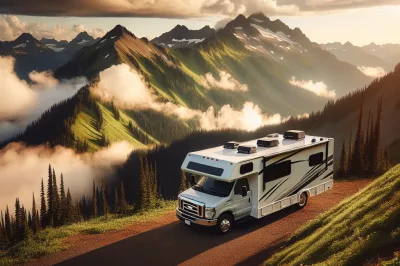Table of Contents

Powering Your Journey: The Basics of Solar Battery Sizing for Your RV
Imagine never having to worry about finding the next plug-in spot for your RV. With solar power, the freedom of the open road is truly in your hands. But before you bask in the sun’s endless energy, there’s a crucial piece of the puzzle: sizing your solar batteries correctly. This isn’t just about getting any battery; it’s about finding the perfect match for your RV’s unique needs.
Article-at-a-Glance: Quick Insights
- Understanding the importance of matching battery size to your RV’s energy needs.
- Identifying key factors that influence your solar battery choice.
- Steps to calculate your energy usage for precise battery sizing.
- Why high capacity batteries are a game-changer for long-term travel.
- Tools and resources to make the battery sizing process hassle-free.
Why Size Matters: Finding the Perfect Battery Fit
It’s a sunny day, and you’re parked in the most picturesque spot, but your lights start to dim, and your fridge is losing its cool. That’s what happens when your solar battery isn’t up to the task. Too small, and you’re left in the dark; too large, and you’ve wasted money and space. The goal is to find that sweet spot where your battery meets your needs without excess.
Key Factors Influencing Your Solar Battery Choice
When you’re picking out a solar battery, think of it like choosing a travel companion. You want reliability, compatibility, and the ability to go the distance. Key factors include your typical energy usage, the type of appliances you run, and the duration of your off-grid adventures. Climate and temperature also play a role—extreme conditions demand more from your battery.
Calculating Your Solar Needs: Starting with the Sun
The sun is your RV’s best friend when it comes to power. To harness its energy effectively, you’ll need to understand your solar needs. Start by considering how much sun your typical destinations receive. This will influence the amount of solar power you can expect to generate and store.
Understanding Your RV’s Energy Consumption
Every appliance in your RV has a story to tell, and it’s measured in watts. Add up the wattage of everything you use—from lights to laptops—and you’ll get a picture of your daily power consumption. This is the foundation of your solar battery sizing. Remember, it’s better to overestimate a bit than to be left wanting more power.
Next, we’ll dive into how to translate this energy consumption into the size of the solar battery you’ll need. Stay tuned as we continue to unravel the essentials of solar battery sizing for your RV, ensuring you’re equipped for energy independence on all your travels.
The Role of Solar Panel Output in Battery Sizing
Think of your solar panels as the fuel pump for your batteries. The more they can pump out, the quicker your batteries charge. Solar panel output is crucial because it determines how much energy you’ll have available to store and use. If your panels can’t produce enough to meet your needs, even the biggest battery won’t save you from running out of power.

Selecting High Capacity Batteries: Types and Benefits
When it comes to powering your adventures, high capacity batteries are the heavy lifters. They store more energy, which means more freedom and less stress about running low on power. High capacity batteries can handle the demands of air conditioning, refrigerators, and other power-hungry appliances, making them ideal for RV enthusiasts who don’t want to compromise on comfort.
Lithium vs. AGM vs. Gel: A Comparison
- Lithium: Lightweight and with a high energy density, lithium batteries charge faster and last longer. They’re the top choice for efficiency and lifespan but come with a higher price tag.
- AGM (Absorbent Glass Mat): These batteries are durable and low maintenance, with a good balance between cost and performance. They handle temperature changes well and are a solid middle-of-the-road option.
- Gel: Gel batteries are robust and spill-proof, with excellent deep cycle capabilities. They’re slower to charge and sensitive to high charging voltages but perform well in extreme temperatures.
Estimating Battery Lifespan and Efficiency
Your solar battery isn’t just a one-and-done purchase; it’s a long-term investment. Estimating its lifespan and efficiency involves looking at cycle life and depth of discharge (DoD). A battery with a high cycle count and a low DoD will serve you reliably for years, ensuring that your solar setup remains a source of power, not problems.
Crunching the Numbers: Battery Sizing Formulas
Getting your battery size right is a bit like baking the perfect cake – it’s all about the right proportions. You’ll need to calculate your total watt-hours per day, then factor in inefficiencies and days of autonomy. It’s a mix of simple math and smart planning to ensure you have enough power to keep the lights on and the fridge cold.
A Simple Step-By-Step Sizing Guide
Here’s a straightforward approach to sizing your battery: First, tally up your daily power usage in watt-hours. Next, decide how many days of energy you want to store for cloudy days or extended stays. Then, choose a battery with a bit more capacity than your calculations suggest, giving you a buffer for unexpected energy needs or less-than-ideal weather conditions.
With these insights, you’re well on your way to selecting a solar battery that will keep your RV powered up for all your travels. Stay tuned for more detailed guidance on installation, maintenance, and maximizing your solar setup’s potential.
Tools and Calculators to Streamline the Process
Now that you know the importance of sizing your solar battery, let’s make it easier with tools and calculators. These handy helpers take the guesswork out of the equation. You’ll find online calculators where you input your daily power usage, and voilà, they suggest the battery size you need. Some even consider the number of sun hours in your typical camping spots. It’s like having a solar expert in your pocket!

Installation Essentials: Setting Up Your Solar Batteries
Once you’ve got the perfect battery, it’s time to install it. Proper installation is key to safety and efficiency. You’ll want to secure your batteries in a spot that’s accessible for maintenance but protected from the elements. Ventilation is crucial for lead-acid batteries, while lithium batteries are more flexible with placement.
Mounting and Wiring for Optimal Performance
Mounting your batteries correctly ensures they stay safe on bumpy roads. Use sturdy brackets and avoid placing batteries in high-temperature areas. When wiring, use the right gauge of wire to handle the current, and secure all connections tightly. This prevents power loss and potential fire hazards. Always follow the manufacturer’s guidelines for the best results.
Maintenance Best Practices to Extend Battery Life
Like any good relationship, the one with your solar battery needs regular attention. For lead-acid batteries, check the water level and top up with distilled water as needed. Keep terminals clean and tight to prevent corrosion. For all battery types, a periodic check-up to ensure they’re charging and discharging correctly will go a long way in extending their life.
Smart Solar Strategies: Maximizing Battery Usage
You’ve got the power, now let’s make the most of it. Smart solar strategies involve managing your energy usage, so you’re never left in the dark. Start by using energy-intensive appliances like air conditioners and microwaves during peak sun hours. Then, switch to energy-saving modes on devices whenever possible.
Battery Management Systems (BMS) Explained
A Battery Management System is like the brain of your solar battery setup. It monitors your battery’s health, ensuring it charges and discharges within safe parameters. This clever system can extend your battery’s life by preventing overcharging and deep discharging. It’s an investment in peace of mind, knowing your solar power system is operating at its best.
Integrating Renewable Energy Sources
Going solar is just the beginning. Integrating other renewable energy sources like wind or hydro can create a hybrid system for even more power autonomy. Imagine harnessing the breeze that cools you on a hot day to charge your batteries! By combining multiple sources, you ensure a steady supply of power and reduce reliance on any single source, making your RV life even more sustainable.
Road-Tested Recommendations: High Capacity Battery Picks
Choosing the right high capacity battery can feel overwhelming, but it doesn’t have to be. I’ve gathered some top picks that have proven their worth on the road. These batteries have been tested by fellow RV enthusiasts and have come out on top for reliability, durability, and performance.
Top Picks for Diverse RV Sizes and Needs
- Battle Born LiFePO4 – Ideal for those seeking a lightweight, high-performance option with a long lifespan.
- Renogy Deep Cycle AGM Battery – A solid choice for RVers who want a balance of price and quality.
- Vmaxtanks VMAXSLR125 AGM 12V – Great for those needing a rugged battery that can handle frequent deep cycling.
- Lion Energy Safari UT – Perfect for tech-savvy travelers looking for cutting-edge lithium technology.
- Trojan T-105 RE Flooded Lead Acid – Best for the budget-conscious RVer who doesn’t mind regular maintenance.
Trusted Brands in the RV Solar Power Realm
When you’re investing in a solar setup, you want to go with brands that stand the test of time. Companies like Battle Born, Renogy, and Victron Energy have earned their stripes in the RV community. They not only provide high-quality batteries but also offer robust customer support and warranties that give you peace of mind on the road.
Stay Empowered: Key Takeaways for Solar Battery Sizing
- Accurate battery sizing is essential for a worry-free RV experience.
- Consider your energy usage, solar panel output, and the type of battery that best suits your travel style.
- High capacity batteries offer more freedom but require careful selection and maintenance.
- Integrating multiple renewable energy sources can provide a more reliable power supply.
- Choose trusted brands that offer quality products and solid customer support.
Frequently Asked Questions (FAQ)
How Do I Know If My Solar Battery Capacity Is Sufficient for My RV?
It’s all about balance. If your RV’s lights and gadgets stay on without a hitch, and you have some power to spare, you’re set. But if you notice your battery struggling to keep up, it’s a sign to reassess. Keep an eye on your energy usage versus battery capacity, especially after adding new appliances or during long stays off-grid.
Can I Use Regular Car Batteries for My RV Solar System?
Regular car batteries are sprinters; they give quick bursts of energy to start engines. Your RV solar system, however, needs a marathon runner – something that can sustain long, steady discharges. That’s why deep-cycle batteries are the way to go. They’re built to provide power over longer periods, perfect for your living space on wheels.
How Often Should I Replace My RV’s Solar Batteries?
The lifespan of your solar batteries hinges on the type, usage, and how well you treat them. For example, lead-acid batteries typically last 3-5 years, while lithium can go for 10 years or more. Keep tabs on their performance, and when you start seeing significant dips in capacity, it’s time for a change.
What Should I Do If My RV’s Energy Needs Increase?
What Should I Do If My RV’s Energy Needs Increase?
If your RV starts demanding more power, don’t sweat it. You have options. You can upgrade to a battery with more oomph, or add more batteries to your existing setup. Also, consider beefing up your solar panel array to ensure it can keep up with the increased demand. It’s like giving your RV a power makeover.
Is It Possible to Overcharge Solar Batteries, and How Can I Prevent It?
Overcharging is a real no-no for solar batteries. It can cut their journey short. The best way to avoid this is by using a charge controller. It’s like a traffic cop for your solar system, making sure your batteries get just the right amount of charge and nothing more.
As you wrap up your solar battery sizing adventure, remember that this isn’t just about powering your RV – it’s about powering your dreams. With the right solar battery, the horizon is endless, and your home on wheels becomes a beacon of freedom and sustainability. So, hit the road with confidence, knowing you’ve got the power you need for every mile and smile ahead.
And there you have it, folks – a fully charged guide to solar battery sizing for your RV. Whether you’re a weekend warrior or a full-time road tripper, the right solar setup can make all the difference. Safe travels and sunny days to you all!
- Boondocking RVs: Flexible Solar Solutions – 3 March 2024
- Renewable Energy Tips for Full-Time Boondocking RVers – 2 March 2024
- Boondocking Solar Power Systems: Sizing Options & Solutions for Motorhomes – 1 March 2024
